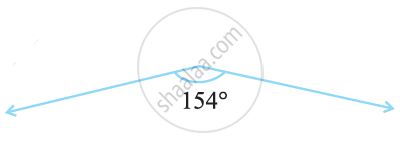Advertisements
Advertisements
प्रश्न
उत्तर
If the sum of the measures of two angles is 90°, they are known as complementary angles.
(i) m∠B + m∠N
= 60° + 30°
= 90°
∴ ∠B and ∠N are complementary angles.
(ii) m∠Y + m∠E
= 90° + 0°
= 90°
∴ ∠Y and ∠E are complementary angles.
(iii) m∠D + m∠F
= 75° + 15°
= 90°
∴ ∠D and ∠F are complementary angles.
If the sum of the measures of two angles is 180°, they are known as supplementary angles.
(iv) m∠B + m∠G
= 60° + 120°
= 180°
∴ ∠B and ∠G are supplementary angles.
(v) m∠N + m∠J
= 30° + 150°
= 180°
∴ ∠N and ∠J are supplementary angles.
संबंधित प्रश्न
Find the supplement of the following angle:

Can two angles be supplementary if both of them are obtuse?
Among two supplementary angles, the measure of the larger angle is 44o more than the measure of the smaller. Find their measures.
(a + 30)° and (2a)° are the measures of two supplementary angles. What is the measure of each angle?
80° and 180° are supplementary
From the figure given below, classify the following pair of angles into supplementary and non supplementary
Angles which are both supplementary and vertically opposite are ______.
An angle which is half of its supplement is of ______.
Two right angles are always supplementary to each other.
If the complement of an angle is 62°, then find its supplement.
